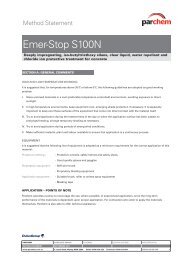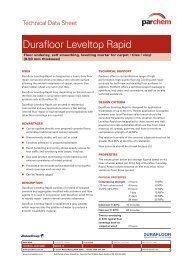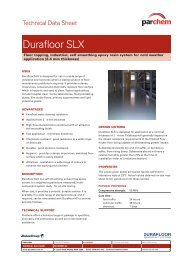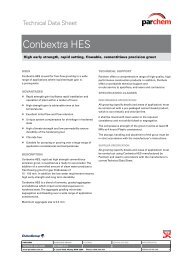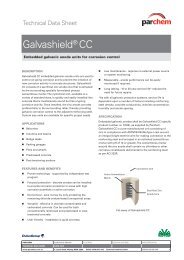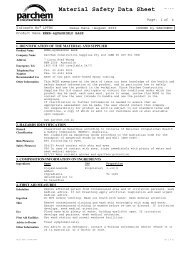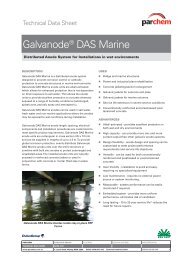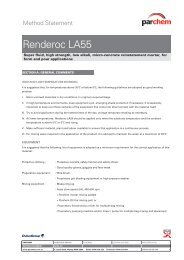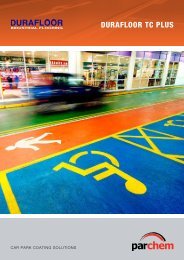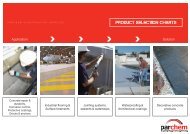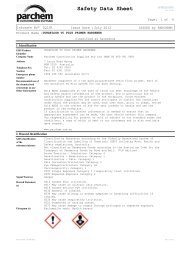Emer-Seal Roadseal SL SDS - Parchem
Emer-Seal Roadseal SL SDS - Parchem
Emer-Seal Roadseal SL SDS - Parchem
You also want an ePaper? Increase the reach of your titles
YUMPU automatically turns print PDFs into web optimized ePapers that Google loves.
Material Safety Data SheetCS: 1.5.31Page: 1of6Infosafe No LPTDF Issue Date : September 2011 ISSUED by PARCHEMDProduct Name EMER-SEAL ROADSEAL <strong>SL</strong>Not classified as hazardous1. IDENTIFICATION OF THE MATERIAL AND SUPPLIERProduct Name EMER-SEAL ROADSEAL <strong>SL</strong>Company Name <strong>Parchem</strong> Construction Supplies Pty Ltd (ABN ABN 80 069 961)Address7 Lucca Road WyongNSW 2259 Australia<strong>Emer</strong>gency Tel. Australia 1800 638 556 and New Zealand 0800 154 666 (both available 24/7)Telephone/Fax Tel: 02 4350 5000NumberFax: 02 4351 2024Recommended Use One part non-sag silicone rubber joint sealant for roads, runways, carparksand pavements.Other Information Distributed in New Zealand by:Concrete Plus23 Watts RoadSockburnNew ZealandTel: (03) 343 0090Fax: (03) 343 0202This M<strong>SDS</strong> summarises at the date of issue our best knowledge of the health andsafety hazard information of the product, and in particular how to safelyhandle and use the product in the workplace. Since <strong>Parchem</strong> ConstructionSupplies Pty Ltd cannot anticipate or control the conditions under which theproduct may be used, each user must, prior to usage, review this M<strong>SDS</strong> in thecontext of how the user intends to handle and use the product in theworkplace.If clarification or further information is needed to ensure that anappropriate assessment can be made, the user should contact this company.Our responsibility for product as sold is subject to our standard terms andconditions, a copy of which is sent to our customers and is also availableupon request.Australia: www.parchem.com.auNew Zealand: www.parchem.co.nz2. HAZARDS IDENTIFICATIONHazardClassificationNot classified as hazardousAustralia:Not classified as Hazardous according to criteria of National OccupationalHealth & Safety Commission, Australia (NOHSC).Not classified as Dangerous Goods according to the Australian Code for theTransport of Dangerous Goods by Road and Rail.New Zealand:Classified as Hazardous according to the Hazardous Substances (Minimum Degreesof Hazard) Regulations 2001, New Zealand.Not classified as Dangerous Goods for transport according to the New ZealandStandard NZS 5433:2007 Transport of Dangerous Goods on Land.HSNO Classification:6.4A - Substance that is irritating to the eyes6.5B - Substance that is a contact sensitiser6.9B - Substance that is harmful to human target organs or systems(Inhalation, Repeated exposure)9.4A - Substance that is very ecotoxic to terrestrial invertebratesHazard statement codes:H317 May cause an allergic skin reaction.H319 Causes serious eye irritation.H373 May cause damage to organs by inhalation through prolonged or repeatedexposure.H441 Very toxic to terrestrial invertebrates.Print Date: 22/09/2011 CS: 1.5.31
Material Safety Data SheetCS: 1.5.31Page: 2of6Infosafe No LPTDF Issue Date : September 2011 ISSUED by PARCHEMDProduct Name EMER-SEAL ROADSEAL <strong>SL</strong>Not classified as hazardousPrecautionary statement codes - Prevention:P103 Read label before use. -This statement applies only where the substanceis available to the general public.P104 Read Safety Data Sheet before use.P260 Do not breathe mist/vapours/spray.P264 Wash skin thoroughly after handling.P272 Contaminated work clothing should not be allowed out of the workplace.P273 Avoid release to the environment. -This statement does not apply wherethis is the intended use.P280 Wear protective gloves/protective clothing/eye protection/faceprotection.Precautionary statement codes - Response:P314 Get medical advice/attention if you feel unwell.P391 Collect spillage.EYES:P305+P351+P338 IF IN EYES: Rinse cautiously with water for several minutes.Remove contact lenses, if present and easy to do. Continue rinsing.P337+P313 If eye irritation persists: Get medical advice/attention.SKIN:P363 Wash contaminated clothing before reuse.P302+P352 IF ON SKIN: Wash with plenty of soap and water.P333+P313 If skin irritation or rash occurs: Get medical advice/attention.Precautionary statement codes - Storage:No storage statement codes.Precautionary statement codes - Disposal:P501 In the case of a substance that is in compliance with a HSNO approvalother than a Part 6A (Group Standards) approval, a label must provide adescription of one or more appropriate and achievable methods for the disposalof a substance in accordance with the Hazardous Substances (Disposal)Regulations 2001. This may also include any method of disposal that must beavoided. See Section 13 for disposal details.3. COMPOSITION/INFORMATION ON INGREDIENTSIngredientsNameCASProportion Hazard Symbol Risk PhraseDimethyl70131-67-8 30-60 %Siloxane,Hydroxy-terminatedLimestone 1317-65-3 10-30 %Polydimethylsilox 63148-62-9 10-30 %ane2-butanone-O,O',O 34036-80-1
Material Safety Data SheetCS: 1.5.31Page: 3of6Infosafe No LPTDF Issue Date : September 2011 ISSUED by PARCHEMDProduct Name EMER-SEAL ROADSEAL <strong>SL</strong>First Aid FacilitiesAdvice to DoctorOther InformationNot classified as hazardousEyewash and normal washroom facilities.Treat symptomatically.For advice in an emergency, contact a Poisons Information Centre (PhoneAustralia 13 1126; New Zealand 0800 POISON / 0800 764 766) or a doctor atonce.5. FIRE FIGHTING MEASURESSuitableUse carbon dioxide, dry chemical, foam, water spray or water fog.Extinguishing MediaHazards from Under fire conditions this product may emit toxic and/or irritating fumes,Combustion smoke and gases, including carbon monoxide, carbon dioxide, oxides ofProductsnitrogen, silicon dioxide, methyl ethyl ketone and formaldehyde.Specific Hazards Combustible substance. This product will burn if exposed to fire.Decomposition 225°C approx.Temp.Precautions inconnection with FireFire fighters should wear Self-Contained Breathing Apparatus (SCBA) and fullprotective clothing to prevent exposure to vapours, fumes or products ofcombustion. Water spray may be used to cool down heat-exposed containers. Ifsafe to do so, remove containers from path of fire. Do not allow run-off fromfire fighting to enter drains or water courses.6. ACCIDENTAL RELEASE MEASURES<strong>Emer</strong>gencyProcedures7. HANDLING AND STORAGEPrecautions for SafeHandlingConditions for SafeStorageWear appropriate personal protective equipment and clothing to preventexposure. Extinguish or remove all sources of ignition and stop leak if safeto do so. Increase ventilation. Evacuate all unprotected personnel. Ifpossible contain the spill. Place inert absorbent, non-combustible materialonto spillage. Use clean non-sparking tools to collect the material and placeinto suitable labelled containers for subsequent recycling or disposal.Dispose of waste according to the applicable local and national regulations.If contamination of sewers or waterways occurs inform the local water andwaste management authorities in accordance with local regulations.Use only in a well ventilated area. Keep containers sealed when not in use.Prevent the build up of mists or vapours in the work atmosphere. Avoidinhalation of vapours and mists, and skin or eye contact. Do not use nearignition sources. Do not pressurise, cut, heat or weld containers as they maycontain hazardous residues. Maintain high standards of personal hygiene i.e.Washing hands prior to eating, drinking, smoking or using toilet facilities.Store in a cool, dry, well-ventilated area away from sources of ignition,oxidising agents, strong acids, foodstuffs, and clothing. Keep containersclosed when not in use and securely sealed and protected against physicaldamage. Inspect regularly for deficiencies such as damage or leaks. Haveappropriate fire extinguishers available in and near the storage area. Takeprecautions against static electricity discharges. Use proper groundingprocedures. For information on the design of the storeroom, reference shouldbe made to Australian Standard AS1940 - The storage and handling of flammableand combustible liquids. Reference should also be made to all applicable localand national regulations.8. EXPOSURE CONTROLS/PERSONAL PROTECTIONNational ExposureStandardsBiological LimitValuesEngineeringControlsNo exposure standards have been established for the mixture by the NationalOccupational Health & Safety Commission (NOHSC), Australia or the OccupationalSafety and Health Service (OSH) of the New Zealand Department of Labour.However, over-exposure to some chemicals may result in enhancement ofpre-existing adverse medical conditions and/or allergic reactions and shouldbe kept to the least possible levels.No biological limit allocated.Use with good general ventilation. If mists or vapours are produced, localexhaust ventilation should be used.Print Date: 22/09/2011 CS: 1.5.31
Material Safety Data SheetCS: 1.5.31Page: 4of6Infosafe No LPTDF Issue Date : September 2011 ISSUED by PARCHEMDProduct Name EMER-SEAL ROADSEAL <strong>SL</strong>RespiratoryProtectionEye ProtectionHand ProtectionBody ProtectionNot classified as hazardousIf engineering controls are not effective in controlling airborne exposurethen an approved respirator with a replaceable mist filter should be used.Reference should be made to Australian/New Zealand Standards AS/NZS 1715,Selection, Use and Maintenance of Respiratory Protective Devices; and AS/NZS1716, Respiratory Protective Devices, in order to make any necessary changesfor individual circumstances.Safety glasses with side shields or chemical goggles should be worn. Finalchoice of appropriate eye/face protection will vary according to individualcircumstances. Eye protection devices should conform with Australian/NewZealand Standard AS/NZS 1337 - Eye Protectors for Industrial Applications.Wear gloves of impervious material. Final choice of appropriate gloves willvary according to individual circumstances i.e. methods of handling oraccording to risk assessments undertaken. Reference should be made to AS/NZS2161.1: Occupational protective gloves - Selection, use and maintenance.Suitable protective work wear, e.g. cotton overalls buttoned at neck and wristis recommended. Chemical resistant apron is recommended where large quantitiesare handled.9. PHYSICAL AND CHEMICAL PROPERTIESAppearance Pigmented pasteOdourMild organic odourDecomposition 225°C approx.TemperatureMelting Point 76°C (approximate)Boiling Point 225°C (approximate)Solubility in Water InsolubleSpecific Gravity 1.17 (approximate)pH ValueNot applicableVapour Pressure Not availableVapour Density Not available(Air=1)Volatile Component Small amounts of volatiles evolved during cure.Flash PointNot availableFlammability Non-combustibleAuto-Ignition Not applicableTemperatureFlammable Limits - Not applicableLowerFlammable Limits - Not applicableUpper10. STABILITY AND REACTIVITYChemical Stability Stable under normal conditions of storage and handling.Conditions to Avoid Avoid contact with water.IncompatibleMaterialsHazardousDecompositionProductsHazardous ReactionsHazardousPolymerizationIncompatible with strong acids and oxidising agents. A component of thisproduct, Phenyl Oximino will react violently in contact with electrophilessuch as Ferric Chloride. Phenyl oximino silane will emit 2-butanone oxime ifexposed to water.Thermal decomposition may result in the release of toxic and/or irritatingfumes including carbon monoxide, carbon dioxide, oxides of nitrogen andformaldehyde.On contact with water and during curing this product releases 2-butanone oxime(methylethyl ketoxime) which is a skin and eye irritant and may have asensitising effect on the skin.Will not occur.Print Date: 22/09/2011 CS: 1.5.31
Material Safety Data SheetCS: 1.5.31Page: 5of6Infosafe No LPTDF Issue Date : September 2011 ISSUED by PARCHEMDProduct Name EMER-SEAL ROADSEAL <strong>SL</strong>Not classified as hazardous11. TOXICOLOGICAL INFORMATIONToxicologyNo toxicity data is available for this specific product.InformationInhalationInhalation of product vapours may cause irritation of the nose, throat andrespiratory system.IngestionIngestion of this product may irritate the gastric tract, causing nausea andvomiting.SkinMay be irritating to skin. The symptoms may include redness, itching andswelling.EyeMay be irritating to eyes. The symptoms may include redness, itching andtearing.Chronic Effects Formaldehyde is listed as a Group 1: Carcinogenic to humans by theInternational Agency for Research on Cancer (IARC). It is a known animalcarcinogen and has been shown to cause cancer of the nasal passages inanimals. Formaldehyde is classified as a Category 3 Carcinogen by theNational Occupational Health And Safety Commission (NOHSC). Formaldehyde isirritating to the eyes, nose, throat and skin and is a dermal sensitiser.Other Information Methyl ethyl ketoxime (formed by exposure of phenyl oximino silane to water)may cause skin or respiratory sensitisation and irritiation.Toxicity data for the by-product, methyl ethyl ketoxime (formed by exposure ofphenyl oximino silane to water) is shown below:LD50 (rat, oral) = 930 mg/kgLD50 (rabbit, dermal) = 200 µL/kgMethyl ethyl ketoxime (MEKO) has been classified as a Category 3 Carcinogen.MEKO is a suspected carcinogen in animals but is not known to be carcinogenicto humans.This product contains polydimethylsiloxanes, which can generate formaldehydewhen heated above 150°C in the presence of air.Toxicity data for the by-product, formaldehyde (formed by thermaldecomposition of polydimethylsiloxanes) is shown below:LC50 (rat, inhalation) = 203 mg/m³LD50 (rat, oral) = 100 mg/kgLD50 (rabbit, dermal) = 270 mg/kg12. ECOLOGICAL INFORMATIONEcotoxicityNo ecological data are available for this material.Persistence / Not availableDegradabilityMobilityInsoluble in water.Bioaccumulative Not availablePotentialEnviron. Protection Prevent this material entering waterways, drains and sewers.13. DISPOSAL CONSIDERATIONSDisposalConsiderationsProduct Disposal:Product wastes are controlled wastes and should be disposed of in accordancewith all applicable local and national regulations. This product can bedisposed through a licensed commercial waste collection service. The productshould be rendered non-hazardous before being sent to a licensed landfillfacility. Alternatively, as the product is combustible, it can be sent to anapproved high temperature incineration plant for disposal.Personal protective clothing and equipment as specified in Section 8 of this<strong>SDS</strong> must be worn during handling and disposal of this product. The ventilationrequirements as specified in the same section must also be followed, and theprecautions given in Section 7 of this <strong>SDS</strong> regarding handling must also befollowed.Do not dispose into the sewerage system. Do not discharge into drains orwatercourses or dispose where ground or surface waters may be affected.In New Zealand, the disposal agency or contractor must comply with the NewPrint Date: 22/09/2011 CS: 1.5.31
Material Safety Data SheetCS: 1.5.31Page: 6of6Infosafe No LPTDF Issue Date : September 2011 ISSUED by PARCHEMDProduct Name EMER-SEAL ROADSEAL <strong>SL</strong>Not classified as hazardousZealand Hazardous Substances (Disposal) Regulations 2001. Further detailsregarding disposal can be obtained on the EPA New Zealand website underspecific group standards.Container Disposal:The container or packaging must be cleaned and rendered incapable of holdingany substance. It can then be disposed of in a manner consistent with that ofthe substance it contained. In this instance the packaging can be disposedthrough a commercial waste collection service.Alternatively, the container or packaging can be recycled if the hazardousresidues have been thoroughly cleaned or rendered non-hazardous.In New Zealand, the packaging (that may or may not hold any residualsubstance) that is lawfully disposed of by householders or other consumersthrough a public or commercial waste collection service is a means ofcompliance with regulations.14. TRANSPORT INFORMATIONTransportInformationRoad and Rail Transport:Australia:Not classified as Dangerous Goods according to the Australian Code for theTransport of Dangerous Goods by Road and Rail. (7th edition)New Zealand:Not classified as Dangerous Goods for transport according to the NZS 5433:2007Transport of Dangerous Goods on Land.Marine Transport (IMO/IMDG):Not classified as Dangerous Goods by the criteria of the InternationalMaritime Dangerous Goods Code (IMDG Code) for transport by sea.Air Transport (ICAO/IATA):Not classified as Dangerous Goods by the criteria of the International AirTransport Association (IATA) Dangerous Goods Regulations for transport by air.15. REGULATORY INFORMATIONRegulatoryInformationPoisons ScheduleNational and orInternationalRegulatoryInformationHSNO ApprovalNumber16. OTHER INFORMATIONDate of preparationor last revision ofM<strong>SDS</strong>ContactPerson/PointAustralia:Not classified as Hazardous according to criteria of National OccupationalHealth & Safety Commission (NOHSC), Australia.Not classified as a Scheduled Poison according to the Standard for the UniformScheduling of Medicines and Poisons (SUSMP).Not ScheduledNew Zealand:Classified as Hazardous according to the New Zealand Hazardous Substances(Minimum Degrees of Hazard) Regulations 2001.All components of this product are listed on the New Zealand Inventory ofChemicals (NZIoC) or exempted.Group Standard: Construction Products (Subsidiary Hazard) Group Standard 2006HSR002544M<strong>SDS</strong> Reviewed: September 2011Supersedes: October 2006Technical Support: 1800 812 864...End Of M<strong>SDS</strong>...© Copyright ACOHS Pty LtdCopyright in the source code of the HTML, PDF, XML, XFO and any other electronic files rendered by an Infosafe system for Infosafe M<strong>SDS</strong> displayed is the intellectualproperty of Acohs Pty Ltd.Copyright in the layout, presentation and appearance of each Infosafe M<strong>SDS</strong> displayed is the intellectual property of Acohs Pty Ltd.The compilation of M<strong>SDS</strong>'s displayed is the intellectual property of Acohs Pty Ltd.Copying of any M<strong>SDS</strong> displayed is permitted for personal use only and otherwise is not permitted. In particular the M<strong>SDS</strong>'s displayed cannot be copied for the purpose ofsale or licence or for inclusion as part of a collection of M<strong>SDS</strong> without the express written consent of Acohs Pty Ltd.Print Date: 22/09/2011 CS: 1.5.31



